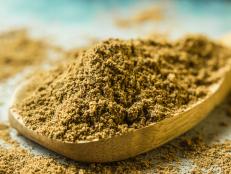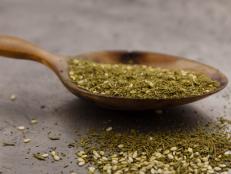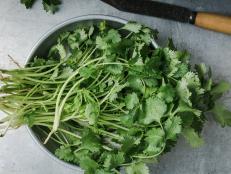What Is Italian Seasoning?
Here, precisely what is in Italian seasoning and how to make it.

JoKMedia/Getty Images
By Krissy Downey for Food Network Kitchen
Krissy is a Digital Culinary Production Fellow at Food Network.
We get it: there are so many different herb and spice mixtures lining the supermarket aisle, it can be difficult to know which one to reach for. Enter Italian seasoning, which is meant to evoke the aromas and flavors of Italy in your own home kitchen. But what exactly is in Italian seasoning, and how should it be used? We’re here to teach you everything you need to know about the spice blend. Let’s get to it.
What Is Italian Seasoning?
Italian seasoning is a mix of dried herbs with an earthy, piney flavor that’s subtly sweet and peppery. Its origins are a bit mysterious, with some people believing it originated in Italy and others insisting it is an American invention. However, the most common understanding is that the Greeks and Romans developed Italian seasoning somewhere in the Mediterranean during ancient times. Today, fresh herbs are a staple in Italian cuisine, so the dried herb mixture is more popular in American or Italian-American home kitchens. It certainly comes in handy, lending a fast extra kick of flavor to anything from salad dressing to branzino.

Sebalos/Getty Images
What Is In Italian Seasoning?
This kitchen staple includes dried basil, dried oregano, dried rosemary, dried thyme and dried marjoram, but there are several variations that also feature additions like dried sage, fennel seeds or even spices like garlic powder or crushed red-pepper flakes. Traditionally, though, it is just those five core herbs. Most grocery stores will carry a few different brands’ Italian seasoning, so you can read the ingredient list on the bottle and decide which one best suits your taste.
How To Make Italian Seasoning
If you’d rather make your own Italian seasoning, it is quite simple and gives you full control of the ingredients. The beauty of making your own spice and herb blends is that you get to decide which flavors to include and how much of each to include, so if you’re partial to a particular dried herb, add in an extra tablespoon or two. Same goes if you don’t like one of the herbs; feel free to just omit it. Here’s what to do.
Ingredients
3 tablespoons dried basil
3 tablespoons dried oregano
3 tablespoons dried rosemary
3 tablespoons dried thyme
3 tablespoons dried marjoram
Optional: dried sage, dried savory, crushed red-pepper flakes or fennel seeds
Instructions
Combine the dried basil, oregano, rosemary, thyme, marjoram and any optional herbs you’d like in a jar with an airtight lid. Write the date on the lid and shake to combine. The mixture will last up to three years in an airtight container away from direct sunlight. Dried herbs don’t technically spoil, they just lose their potency over time, so if you’re wondering whether it is still good, rub a pinch of seasoning in your palm and smell it. If it still gives a strong aroma, it is good to use.

Carlo A/Getty Images
Italian Seasoning Uses
Italian seasoning can be used to flavor just about anything, but some of our favorite uses are in classic Italian-American dishes like meatballs, pizza or chicken Parmesan. It adds extra interest to olive oil for dipping bread or vinaigrette for salads. Or stir it into marinades to infuse your meat with woodsy, herbal flavor. Italian seasoning is a kitchen staple you will turn to again and again to help build flavor in your cooking.
Italian Seasoning Substitutes
Italian seasoning is extremely easy to make, but if you’re in a pinch, there are a few things you can do to achieve similar results. Dried oregano tends to give that warm, savory flavor boost all on its own, but any combination of the Italian seasoning staple spices will give you exactly what you’re looking for. Dried herbs are quite subtle, but for a fresher, more vibrant taste, you can also always use a mixture of chopped fresh herbs in place of Italian seasoning.
Recipes
Let’s put all this chatter to use. These recipes all use Italian seasoning for an extra zing of flavor.

Renee Comet
Dinner on the table in 40 minutes? A one-pan meal? And don’t even get us started on the gooey cheese and tangy balsamic. Trust us on this one.

This is the zesty Italian garden salad of your dreams. It is easy to make, the perfect start to any meal and completely addicting. Don’t forget the breadsticks!

Armando Rafael
Aluminum foil does all the work here. Italian sausage, bell peppers and sweet onion join together in simple foil packs that are tossed on the grill. The foil helps with quick cooking, all while the grill imparts a charred, smokey flavor.

Ryan Dausch
Need we say more? The kids will love helping in the kitchen with this easy recipe, but they’ll love eating the chicken fingers even more. We think the adults will have a hard time resisting a stolen bite here and there too.

Antonis Achilleos
Ground turkey, pesto and ricotta make irresistibly juicy meatballs, but ditalini pasta, hearty greens and parmesan cheese complete this cozy, comforting Italian wedding soup recipe.

Eggplant Parm gets the air-fryer treatment with this lighter, easier version of the delicious Sunday classic. It may be lighter than its pan-fried counterpart, but it sure brings the flavor with rich red sauce and toasty, golden-brown cheese.
Related Links:































































